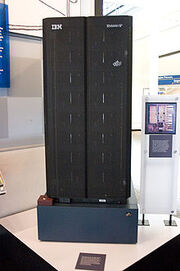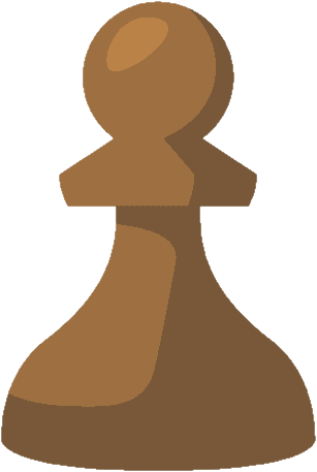Deep Blue was an IBM created Supercomputer designed to defeat world champion Garry Kasparov. On 11 May 1997, the machine won a six-game match by two wins to one with three draws against world champion Garry Kasparov. Kasparov accused IBM of cheating and demanded a rematch, but IBM declined and retired Deep Blue.
Deep Blue succeeded in its goal of winning against a reigning world champion in 1997. Kasparov had won an earlier match against a previous version of Deep Blue in 1996.
History
The computer system dubbed "Deep Blue" was the first machine to win a chess game against a reigning world champion (Garry Kasparov) under regular time controls. This first win occurred on February 10, 1996. Deep Blue - Kasparov, 1996, Game 1 is a famous chess game. However, Kasparov won three games and drew two of the following games, beating Deep Blue by a score of 4–2. The match concluded on February 17, 1996.
Deep Blue was then heavily upgraded (unofficially nicknamed "Deeper Blue")[1] and played Kasparov again in May 1997, winning the six-game rematch 3½–2½, ending on May 11, finally ending in game six. Deep Blue thus became the first computer system to defeat a reigning world champion in a match under standard chess tournament time controls.

The project was started as "ChipTest" at Carnegie Mellon University by Feng-hsiung Hsu; the computer system produced was named Deep Thought after the fictional computer of the same name from The Hitchhiker's Guide to the Galaxy. Hsu joined IBM (Research division) in 1989 and worked with Murray Campbell on parallel computing problems. Deep Blue was developed out of this. The name is a play on Deep Thought and Big Blue, IBM's nickname.
The system derived its playing strength mainly out of brute force computing power. It was a massively parallel, 30-node, RS/6000, SP-based computer system enhanced with 480 special purpose VLSI chess chips. Its chess playing program was written in C and ran under the AIX operating system. It was capable of evaluating 200 million positions per second, twice as fast as the 1996 version. In June 1997, Deep Blue was the 259th most powerful supercomputer, capable of calculating 11.38 gigaflops, although this did not take into account Deep Blue's special-purpose hardware for chess.
The Deep Blue chess computer which defeated Kasparov in 1997 would typically search to a depth of between six and twelve plies to a maximum of forty plies in some situations. An increase in search depth of one ply corresponds on the average to an increase in playing strength of approximately 80 Elo points. Levy and Newborn estimate that one additional ply increases the playing strength 50 to 70 points (Levy & Newborn 1991:192).
Deep Blue's evaluation function was initially written in a generalized form, with many to-be-determined parameters (e.g. how important is a safe king position compared to a space advantage in the center, etc.). The optimal values for these parameters were then determined by the system itself, by analyzing thousands of master games. The evaluation function had been split into 8,000 parts, many of them designed for special positions. In the opening book there were over 4,000 positions and 700,000 grandmaster games. The endgame database contained many six piece endgames and five or fewer piece positions. Before the second match, the chess knowledge of the program was fine tuned by grandmaster Joel Benjamin. The opening library was provided by grandmasters Miguel Illescas, John Fedorowicz and Nick de Firmian. When Kasparov requested that he be allowed to study other games that Deep Blue had played so as to better understand his opponent, IBM refused. However, Kasparov did study many popular PC computer games to become familiar with computer game play in general.
After the loss, Kasparov said that he sometimes saw deep intelligence and creativity in the machine's moves, suggesting that during the second game, human chess players, in violation of the rules, intervened. IBM denied that it cheated, saying the only human intervention occurred between games. The rules provided for the developers to modify the program between games, an opportunity they said they used to shore up weaknesses in the computer's play revealed during the course of the match. This allowed the computer to avoid a trap in the final game that it had fallen for twice before. Kasparov requested printouts of the machine's log files but IBM refused, although the company later published the logs on the Internet at http://www.research.ibm.com/deepblue/watch/html/c.shtml. Kasparov demanded a rematch, but IBM declined and retired Deep Blue.
In 2003 a documentary film was made that explored these claims. Titled Game Over: Kasparov and the Machine, the film implied that Deep Blue's heavily promoted victory was a plot by IBM to boost its stock value.
One of the two racks that made up Deep Blue is on display at the National Museum of American History in their exhibit about the Information Age; the other rack appears at the Computer History Museum in their "Mastering The Game: A History of Computer Chess" exhibit.
Feng-hsiung Hsu later claimed in his book Behind Deep Blue that he had the rights to use the Deep Blue design to build a bigger machine independently of IBM to take Kasparov's rematch offer, but Kasparov refused a rematch (see also Hsu's open letter about the rematch linked below). Kasparov's side responded that Hsu's offer was empty and more of a demand than an offer because Hsu had no sponsors, no money, no hardware, no technical team, just some patents and demands that Kasparov commit to putting his formal world title on the line before further negotiations could even begin (with no guarantees as to fair playing conditions or proper qualification matches).
Deep Blue, with its capability of evaluating 200 million positions per second, was the strongest computer that ever faced a world chess champion. Today, in computer chess research and matches of world class players against computers, the focus of play has often shifted to software chess programs, rather than using dedicated chess hardware. Modern chess programs like Rybka, Deep Fritz or Deep Junior are more efficient than the programs during Deep Blue's era. In a recent match, Deep Fritz vs. Vladimir Kramnik in November 2006, the program ran on a personal computer containing two Intel Core 2 Duo CPUs, capable of evaluating only 8 million positions per second, but searching to an average depth of 17 to 18 plies in the middlegame.
References
- ^ Saletan, William (2007-05-11). Chess Bump: The triumphant teamwork of humans and computers. Slate.
- Hsu, Feng-hsiung (2002), Behind Deep Blue: Building the Computer that Defeated the World Chess Champion, Princeton University Press, ISBN 0-691-09065-3
- Levy, David & Newborn, Monty (1991), How Computers Play Chess, Computer Science Press, ISBN 0-7167-8121-2
